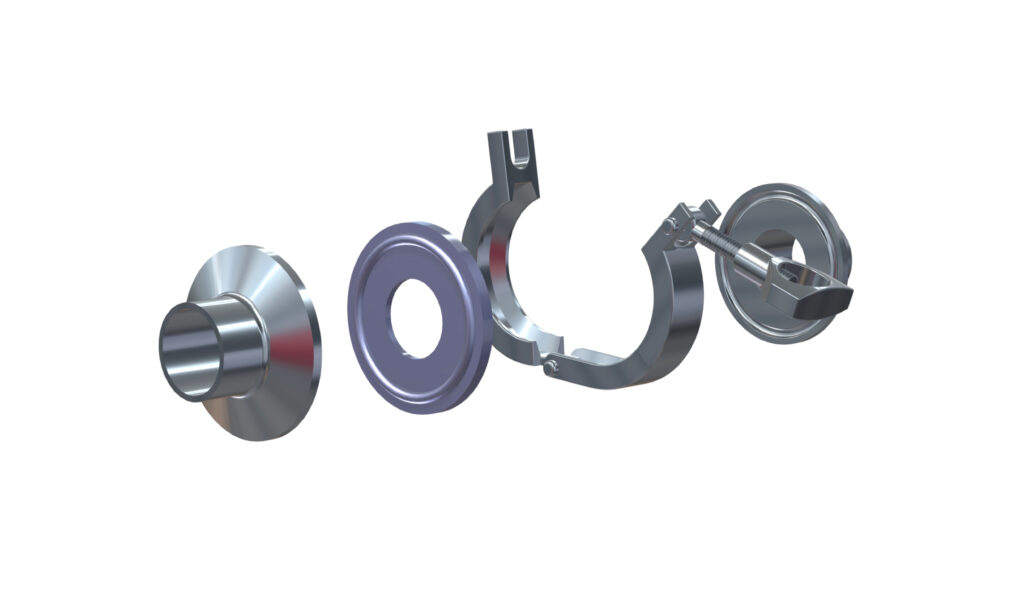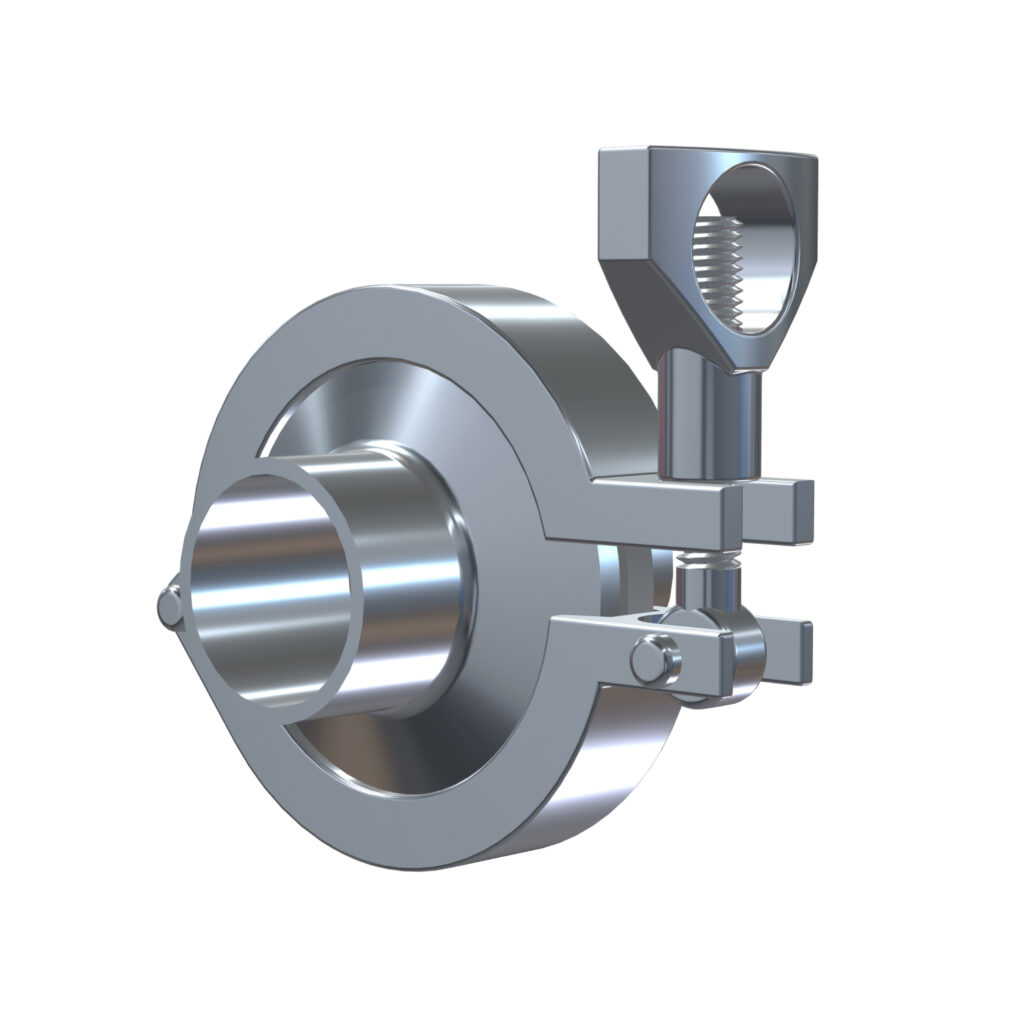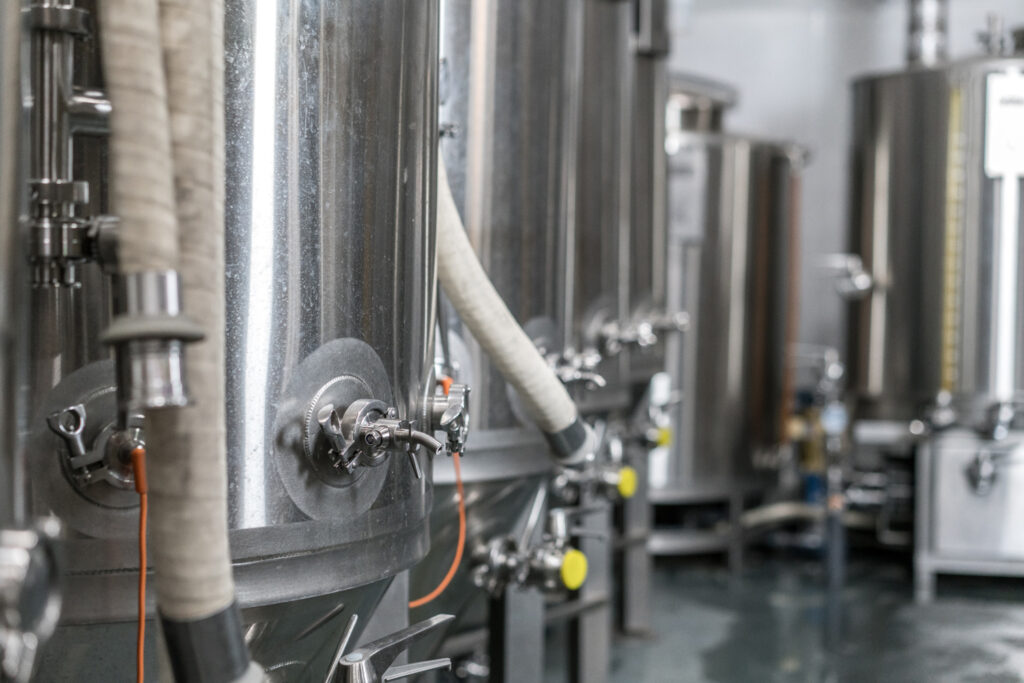Tri Clamp connections are often used in the process industry to connect pipes and equipment. These connections are designed for quick installation and removal, making them ideal for applications where regular maintenance is required.

What are tri clamp connections?
Tri clamp connections are a type of connection that are often used in the process industry. They consist of three main parts: a pipe end, a sealing ring and a clamp. The pipe ends are pushed together and clamped using the clamp, creating a tight and secure connection.

The advantages of tri clamp connections
- Easy to assemble and disassemble: Tri-clamp fittings are designed for easy installation and disassembly, making them ideal for applications where regular cleaning and maintenance are required.
- Reliable sealing: Tri-clamp fittings provide a reliable seal without the risk of leaks. The sealing rings, which are available in different materials, ensure a leak-free seal between the two connections.
- Versatility: Tri-clamp fittings are available in a variety of sizes and materials, making them suitable for a wide variety of applications in a variety of industries.
- Hygienic: Tri-clamp fittings are designed to be hygienic and are therefore suitable for applications in the food industry, pharmaceutical industry and other applications where hygiene is critical.
- Easy to Clean: Tri-clamp fittings are easy to clean and sterilize due to their dead angle design, preventing bacteria and dirt from accumulating.
- Aesthetic: Tri-clamp fittings have a smooth surface and aesthetic appearance, making them popular for applications where appearance is important, such as in the food and cosmetic industries.
- Safety: Tri-clamp fittings provide a safe and reliable connection that can withstand vibration, temperature fluctuations and pressure changes.
- Standardization: Tri-clamp fittings comply with international standards such as ASME-BPE standards and DIN standards, making them readily available and used in a variety of applications.

The disadvantages of tri clamp connections
While tri-clamp connections have many advantages, there are also some disadvantages that should be considered:
- Cost: Tri-clamp fittings can generally be more expensive than other types of fittings. This is because they are designed to strict standards and specifications and use high-quality materials.
- Limited pressure capacity: While tri-clamp fittings are suitable for most industrial applications, they generally have limited pressure capacity compared to other types of connections. This means they may not be suitable for high pressure applications.
- Limited temperature capability: As mentioned earlier, tri-clamp fittings have limited temperature capability and may not be suitable for very high temperature applications.
- Complexity: Tri-clamp fittings are more complex than some other types of fittings, which can lead to difficulties in installation and maintenance.
- Cleaning and sterilization: Although tri-clamp fittings are easy to disassemble and clean, it is important to ensure that no residue remains in the fittings. It can be difficult to fully sterilize the fittings if dirt or microorganisms remain.
While these drawbacks should be considered when selecting the correct connections for a specific application, the benefits of tri-clamp fittings generally outweigh the drawbacks.
Applications of tri clamp connections
Tri clamp connections are widely used in the food industry, pharmaceutical industry and chemical industry. They are used for connecting pipes, tanks, pumps, filters and other equipment. Because they are easy to clean and dismantle, they are ideal for applications where regular maintenance is required.
Tri-clamp fittings are designed to meet the hygiene and safety standards required for food safe applications. They have been widely used in the food and beverage industry due to their hygienic design, reliability and ease of cleaning and maintenance.

The materials from which tri-clamp fittings are made, such as stainless steel and food-grade plastics, are safe for use with food and beverages and can be sterilized to prevent contamination. In addition, tri-clamp fittings are available in sizes and shapes specifically designed for food-safe applications, such as CIP cleaning, pasteurization and other processes in the food industry.
To ensure that tri-clamp fittings are suitable for your specific application, it is important to select the correct materials, sizes and standards that meet the required hygiene and safety standards for your industry and application.
Materials used for tri clamp connections
Tri clamp connections are available in a variety of materials including stainless steel, brass and plastic. Stainless steel is the most common material used for tri clamp connections due to its durability and hygienic properties.
Sealing technologies for tri clamp connections
Various sealing technologies are available for tri clamp connections, including O-rings, lip seals and PTF. O-rings are the most common type of seal for tri clamp connections. They are available in a variety of materials, including silicone, Viton and EPDM, and provide an effective seal against liquids and gases. Lip seals are designed to provide an additional seal and are often made from PTFE or other plastics. PTFE seals offer excellent chemical and thermal resistance and are ideal for applications involving aggressive chemicals.
Installation of tri clamp connections
Installing tri clamp connections is relatively easy and can be done without special tools. The pipe ends must be clean and dry before installation. Place the sealing ring between the pipe ends and slide the clamp over the outer ring of the pipe ends. Tighten the clamp until it is tight and make sure no leakage occurs.
Maintenance of tri clamp connections
To ensure that tri clamp connectionsD continue to function optimally, regular maintenance is required. This includes regularly checking for leaks, replacing worn seals, and checking the clamps for wear or damage. It is also important to clean the joints regularly to prevent a build-up of dirt and bacteria.
Standards
Tri-clamp couplings are available in a variety of piping standards, including:
- ASME BPE: This standard is used for piping in the biotechnology, pharmaceutical and food industries.
- ISO 2852: This is the international standard for hygienic couplings and is widely used in Europe.
- DIN 32676: This German standard is often used in the chemical and pharmaceutical industry.
- BS 4825: This is the British standard for hygienic couplings and is commonly used in the UK and other countries.
- SMS 1145: This Swedish standard is often used in the dairy industry.
It is important to choose the right standard for your application to ensure that the couplings are compatible with other components in the piping and comply with applicable regulations and industry standards.
The different types of tri-clamp fittings
Several types of tri-clamp fittings are available, including:
- Tri-clamp couplings: These are the basic components of a tri-clamp connection. They consist of two opposing ferrules with a sealing ring between them and held together by means of a clamp.
- Tri-clamp bends: These are curved sections of ductwork that are fitted with tri-clamp ferrules at both ends, making them easy to attach to other tri-clamp components.
- Tri-clamp tees: These are Y-shaped sections of pipework with a third outlet, fitted with tri-clamp ferrules on all three ends.
- Tri-clamp crosspieces: These are cross-shaped sections of pipework with four outlets, which are fitted with tri-clamp ferrules on all four ends.
- Tri-clamp reducers: These are components used to reduce or increase the diameter of a tri-clamp connection, for example to change from a large pipe diameter to a smaller diameter.
- Tri-clamp hose connections: These are components used to connect hoses to a tri-clamp system.
- Tri-clamp manifolds: These are components used to split a single tri-clamp connection into multiple separate connections, for example to connect multiple devices to a single pipeline.
Compatibility with other types of connections
Tri-clamp fittings are designed according to specific norms and standards, such as the ASME-BPE code and the DIN-32676 standard, and are therefore not always directly compatible with other connections. However, adapters and transition pieces are available that can be used to connect tri-clamp fittings to other types of fittings.
When choosing an adapter or transition piece, it is important to ensure that it is suitable for the specific application and that it meets the required industry standards and safety regulations. The use of unsuitable adapters or transition pieces can lead to unsafe connections, leaks and possibly even dangerous situations.
Are tri-clamp fittings reusable?
Yes, tri-clamp fittings are generally reusable if properly maintained and inspected before reuse. The design of the tri-clamp fittings makes it easy to assemble and disassemble the fittings quickly without special tools. This makes it possible to reuse the fittings and to clean them easily.
However, it is important to ensure that the fittings are not damaged and that they still meet the required standards and specifications before using them again. This means that the sealing rings should be replaced if they are worn or damaged, and the fittings should be inspected for any cracks, corrosion or other damage that could affect performance or safety.
In addition, you must always store the fittings correctly to prevent damage or contamination. The use of protective covers and storage in a clean and dry environment can extend the life of the fittings and ensure they remain safe and reliable.
Maximum pressure for tri clamp connections
Tri-clamp fittings are designed for hygienic applications in the food, pharmaceutical and biotechnology industries, where the pressure usually does not exceed 10 bar. While tri-clamp fittings are strong and durable, they are generally not suitable for very high pressure applications.
The maximum temperatures for tri clamp connections
The maximum temperature at which tri-clamp fittings can be used depends on several factors, including the material of the fittings, the sealing rings and the application itself. In general, tri-clamp fittings can be used at temperatures up to approximately 150 °C.
At higher temperatures, the material of the fittings can deform or fail, and sealing rings can lose their elasticity and cause leaks. When selecting tri-clamp fittings for a specific application, it is therefore important to take into account the maximum allowable temperature and to choose the right materials that are suitable for that temperature.
Some manufacturers also offer special high-temperature tri-clamp fittings suitable for use at higher temperatures. These fittings are often made of materials such as stainless steel or anodized aluminum and have sealing rings made of heat-resistant materials such as PTFE. It is important to check that these fittings are suitable for your specific application and to take into account the appropriate industry standards and safety regulations.